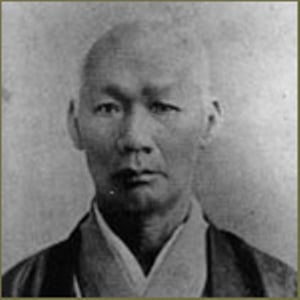Nakahama Manjirō
- This is a Japanese name; the family name is Nakahama.
Nakahama Manjirō (中濱 万次郎 Nakahama Manjirō, 1827-1898), also known as John Manjiro, was one of the first Japanese people to visit the United States and an important translator during the Opening of Japan.[1]
Voyage to America
During his early life, he lived as a simple fisherman in the village of Naka-no-hama, Tosa Province (now Tosashimizu, Kōchi Prefecture). In 1841, 14 year old Nakahama Manjiro and four friends were fishing when their boat was wrecked on the island of Torishima. The American whaler ship John Howland (Captain William H. Whitfield commanding) rescued them and, at the end of the voyage, dropped the others in Honolulu; however Manjiro (nicknamed "John Mung") wanted to stay on the ship. Captain Whitfield took him back to the United States and entrusted him to James Akin, who enrolled Manjiro in Oxford School in the town of Fairhaven, Massachusetts. The boy studied English and navigation for a year, apprenticed to a cooper, and then (with Whitfield's help) signed on to the whaler Franklin (Captain Ira Davis). After whaling in the South Seas, Franklin put into Honolulu in October 1847, where Manjiro again met his four friends. None were able to return to Japan, for this was during Japan's period of isolation when leaving the country was an offense punishable by death.
When Captain Davis became ill and was left in Manila, the crew elected a new captain and Manjiro was made First Mate. Franklin returned to New Bedford in September 1849 and paid off; Manjiro was self-sufficient with $350 in his pocket.
Manjiro promptly set out by sea for the California Gold Rush by ship. Arriving in San Francisco in May 1850, he took a steamboat up the Sacramento River, then a train into the mountains. In a few months, he made about $600 and decided to find a way back to Japan.
Return to Japan
Manjiro arrived in Honolulu and found two of his companions were willing to go with him. He purchased a whaleboat, the Adventure, which was loaded aboard the bark Sarah Boyd (Captain Whitmore) along with gifts from the people of Honolulu. They sailed on December 17, 1850 and reached Okinawa on February 2, 1851. The three were promptly taken into custody, although treated with courtesy. After months of questioning, they were released in Nagasaki and eventually returned home to Tosa where Lord Yamanouchi Toyonobu awarded them pensions. Manjiro was appointed a minor official and became a valuable source of information.
In September 1853, Manjiro was summoned to Edo (now known as Tokyo), questioned by the national government, and made a hatamoto (a samurai in direct service to the shogun). He would now give interviews only in service to the government. In token of his new status, he would wear two swords, and needed a surname; he chose Nakahama, after his home village.
Service as hatamoto
Manjiro detailed his travels in a report to the Bakufu, which is kept today at the Tokyo National Museum. In 1853, when Commodore Matthew Perry's Black Ships arrived to force the opening of Japan, Manjiro became an interpreter and translator for the Shogunate and was instrumental in negotiating the Convention of Kanagawa. However, it appears that he did not contact the Americans directly at that time.
In 1860, Nakahama Manjiro participated in the Japanese Embassy to the United States (1860). He was appointed translator on board Kanrin Maru, Japan's first screw-driven steam warship, purchased from the Dutch. Due to Japan's former policy of isolation, the crew had little experience on the open ocean, and during a storm, her Captain Katsu, Admiral Kimura and much of the crew fell ill. Manjiro was put in charge and brought the ship to port safely.
In 1870, during the Franco-Prussian War, Manjiro studied military science in Europe. He returned to Japan by way of the United States. He was formally received at Washington D.C., and he took advantage of this opportunity by traveling overland to Fairhaven, Massachusetts to visit his "foster father", Captain Whitfield. Eventually, Manjiro became a professor at the University of Tokyo.
Legacy
Manjiro apparently used his know-how of western shipbuilding to contribute to the effort of the Bakufu to build a modern Navy. He translated Bowditch's American Practical Navigator into Japanese, and taught English, naval tactics and whaling techniques. He allegedly contributed to the construction of the Shohei Maru, Japan's first post-seclusion foreign-style warship.
Manjiro was married three times and had seven children. In 1918, his eldest son, Dr. Toichiro Nakahama, donated a valuable sword to Fairhaven in token of his father's rescue and the kindness of the town. It continued to be displayed in the town library even during World War Two.
Among his accomplishments, Manjiro was probably the first Japanese to ride a railroad, in a steamship, to officer an American vessel, and to command a trans-Pacific voyage.
There is a great statue of Manjiro Nakahama at Cape Ashizuri, on Shikoku. In Fairhaven, the Manjiro Historic Friendship Society is renovating William Whitfield's home to include a museum dealing with the Manjiro legacy.[2]
See also
- Hasekura Tsunenaga, the first recorded Japanese to reach the American continent, in 1614
- Otokichi, a famous Japanese castaway to the United States, ten years before Nakahama Manjiro
- Einosuke Moriyama, another translator in the negotiation with Perry
- Ranald MacDonald, the first teacher of English in Japan
- Shimazu Nariakira
ReferencesISBN links support NWE through referral fees
- ↑ *Webber, Bert (1984). Wrecked Japanese Junks adrift in the North Pacific Ocean. Ye Galleon Press. ISBN 0-87770-220X.
- ↑ *Medeiros, Michael (December 8, 2006). Preserving the Manjiro Legacy. South Coast Today. Retrieved June 18, 2008.
External links
fr:Nakahama Manjirō ko:존 만지로 ja:ジョン万次郎


